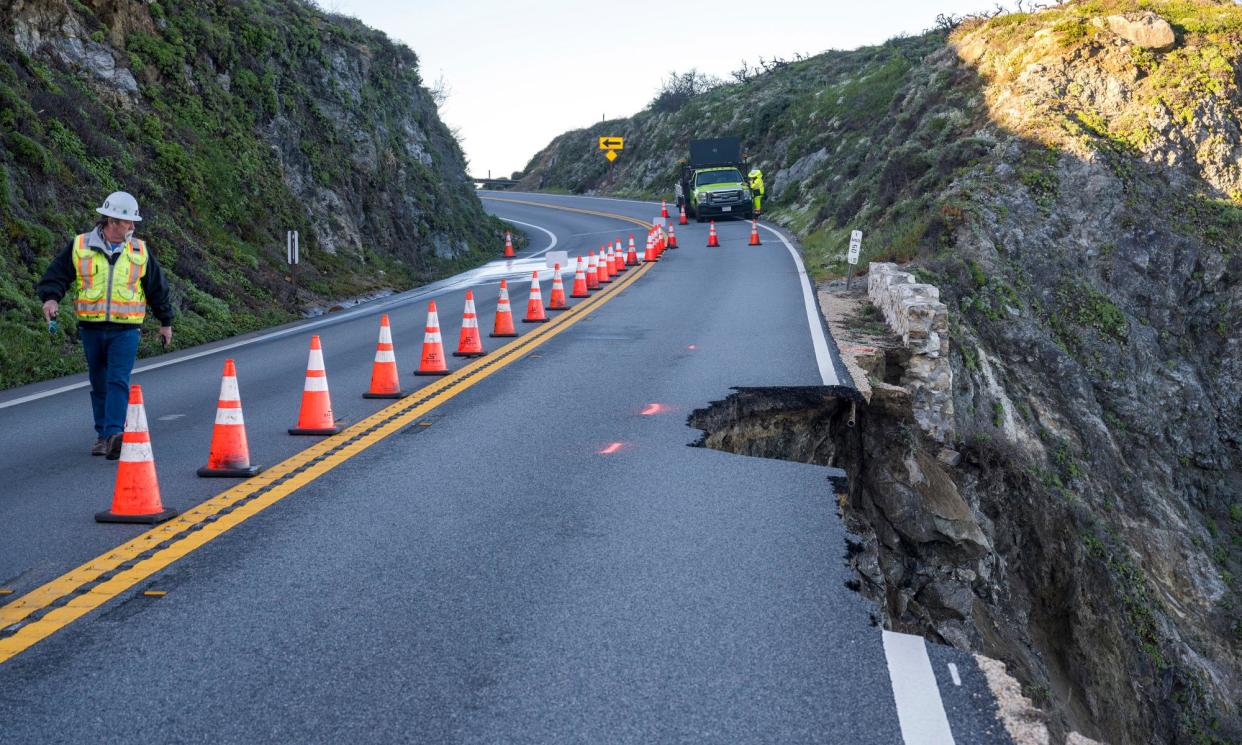California’s Highway 1 road conditions will only get riskier, experts say

A long stretch of California’s famed Highway 1 is closed yet again after a large chunk of the scenic route lining the central coast in Big Sur crumbled into the sea on Saturday. The slide, which occurred just south of the Rocky Creek Bridge, is the latest challenge along the winding roadway, which is facing surges in both popularity and peril.
Caught between rising tides and crumbling cliff sides, conditions are becoming more extreme as the climate crisis exacerbates the issues. No one has been injured this week, according to officials – but the risks of travelling this road are only going to grow.
Related: California’s Highway 1 remains closed after road collapsed in storm
“We have been lucky,” said Dr Gary Griggs, a coastal erosion expert at University of California, Santa Cruz, of the safety record along the most rugged stretches of this road. Fast-moving debris flows and the underground churn that chews through the concrete can cause fatalities if cars are caught in the frey. “Almost a century since it was built and it has been slide after slide after slide,” he added. “Nothing is ever going to change that, and, with these climate change indicators, it will probably get worse.”
Built in the 1930s, it’s rumored the highway has never been fully operational from north to south for more than a year since its inauguration. The most recent slide adds to three others to the south that have kept the picturesque thoroughfare between San Francisco and Los Angeles closed for more than a year.
With more wet weather in the forecast and crews unable to access the slide from the south, it’s unclear at this point when the route will be accessible again. “This is a critical stretch of highway,” said Kevin Drabinski, a spokesperson with California’s department of transportation, noting that locals rely on the route for emergency response and resources. CalTrans engineers were on site Monday morning assessing the gaping bite missing from the roadway, as officials helped guide thousands of stranded tourists and residents as they crept slowly past the precarious spot.
Convoys are scheduled twice a day to ensure safe passage, but they will be cancelled if another strong storm blows through. Residents are often well-equipped with supplies and work-arounds, accustomed to hard-but-beautiful living when nature unleashes its fury on a rugged landscape, but it still adds hardships when the road is closed in multiple areas.
Drabinski said that lessons are learned from each event that help streamline the response and recovery after an incident, but “every slide has its own unique personality”. It’s often difficult to assess how long repairs can take.
It is clear that it won’t be an easy fix – and it certainly won’t be the last. Maintaining Highway 1 has become somewhat of a Sisyphean task, with evidence of past engineering successes and failures etched into the concrete. The state has poured millions of dollars into project after project.
“In some ways it was amazing that they were able to carve that road through there and even maintain it as well as they have,” Griggs said. Snaking through the slopes through fractured rocks and over drainages, the highway was always prone to failure. “Now the climate is changing and these atmospheric rivers are pounding it,” he added. “We have to expect this is going to happen and it may happen more frequently in the future.”
There have been solutions floated, including adding a toll to help finance the repairs or perhaps a tunnelling system that would strengthen the route. Griggs thinks the former has potential and the latter much less so. But for now, California appears determined to keep paying the hefty price tag. Just as determined as the millions of tourists who come from around the world to drive California’s most famous road are to face the risks.
“There is another route – if you want to drive up safely you go up 101,” Griggs said. “But you see lettuce and vegetables along that route. You don’t see the spectacular Big Sur coast that people want to see.”


